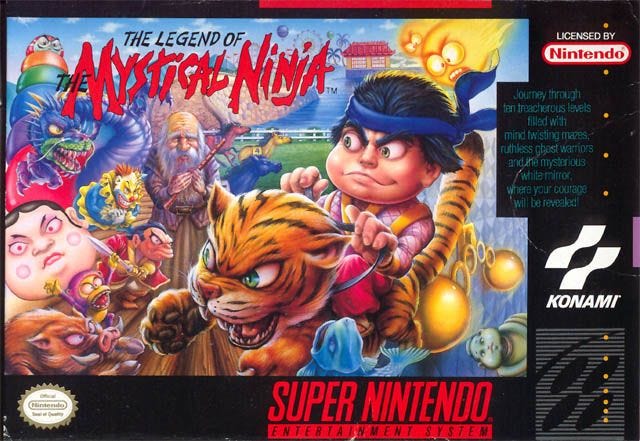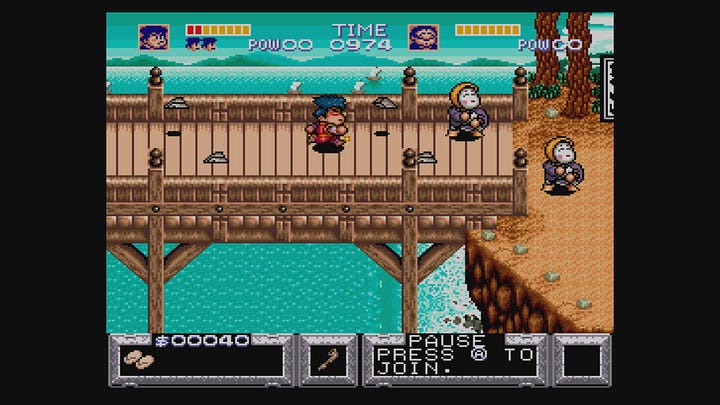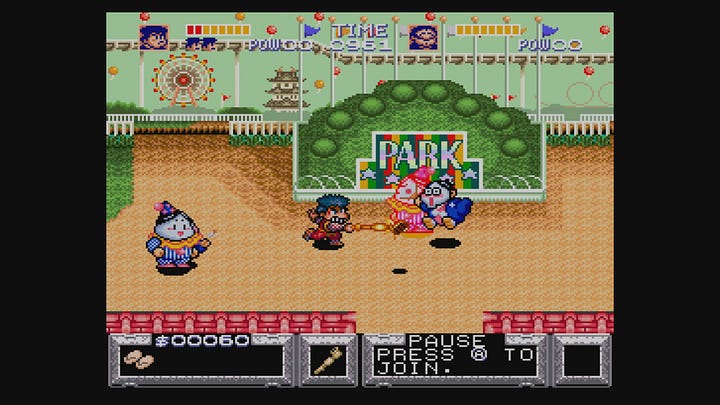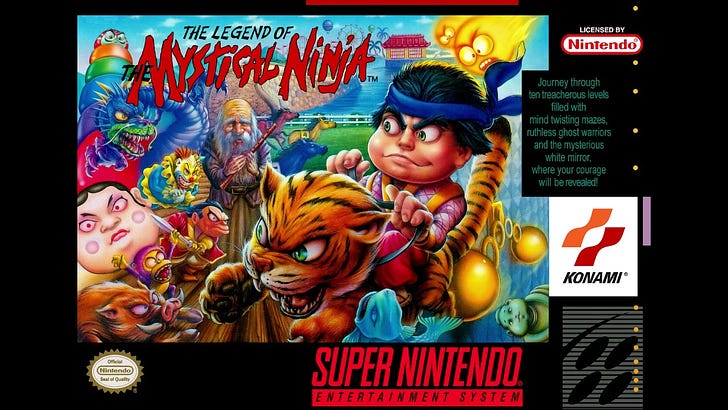Re-release this: The Legend of the Mystical Ninja
One of the few Goemon games to ever make it out of Japan is also a classic.
This column is “Re-release this,” which will focus on games that aren’t easily available, or even available at all, but should be once again. Previous entries in this series can be found through this link.
The Goemon series is one that Konami, for a couple of decades, was impressively dedicated to. The first game, Mr. Goemon, appeared in arcades in 1988: Konami would release 22 more mainline games (including remakes and mobile titles) by 2005, with seven spin-offs in that same stretch for an even 30 games total. And that’s also all they’ve done to this point for the franchise: the last Goemon game was Ganbare Goemon: Tōkai Dōchū Ōedo Tengu ri Kaeshi no Maki, released for the Nintendo DS in 2005, and only in Japan.
It wouldn’t be surprising if the lack of new Goemon in the nearly 20 years since had gone without your notice, given that the last game in the series to make it to North America was even further back, in 1999, when Goemon’s Great Adventure released on the Nintendo 64. That, by the way, was just the fourth Goemon game to leave Japan for North America, despite being the 14th mainline entry. It’s been a Japan-centric series in both its style and its tendency to stay regional, which is a considerable shame given the quality of these titles. It wouldn’t be surprising at all, really, if the only reason the N64 even received two Goemon games in the first place — the lone platform to get more than one in North America until the Nintendo 3DS saw a couple of Virtual Console re-releases years later — is because Konami thought that maybe they’d stand out on a console with a much smaller library of games to choose from than Sony’s Playstation. The PSX saw four Goemon games, three mainline and one spin-off, and none of them left Japan — the Playstation would see nearly 1,300 games released in North America, the N64 just 296, so even something as “odd” and relatively unknown as Goemon might stick out on the smaller platform.
Konami wasn’t wrong, either, as Mystical Ninja Starring Goemon sold 200,000 copies worldwide, and Goemon’s Great Adventure 160,000: those numbers seem small, but they were decent for the N64 and its comparatively small install base — especially for a third-party publisher — and in most cases also enough to trigger development of a sequel. Just 49 N64 games ever hit one million sales, and 38 of those were published by Nintendo, with another three from Rare: nearly the entirety of the rest were high-quality licensed games (wrestling, Tony Hawk, James Bond), then the first two Turok titles, and Namco Museum. With that in mind, 360,000 copies sold of two games that were very openly weird (complimentary) doesn’t sound so bad.


The numbers weren’t lofty enough for Konami to continue their support of the series in the west, however, so Goemon’s Great Adventure would prove to be the final word on his series outside of Japan, outside of later digital re-releases of a couple of titles. Really, it’s kind of a miracle that North America even received the ones they did, considering that The Legend of the Mystical Ninja served as the series’ debut, and, despite critical acclaim, didn’t catch on sales-wise outside of Japan. The game sold 480,000 copies in Japan alone against an eventual install base of 17.7 million Super Famicoms, and in North America, it sold… less. Official sales figures were never released, but there were three (ambitious) follow-ups to The Legend of the Mystical Ninja on the Super Famicom that stayed in Japan, which should be evidence enough of how things went.
Ignore the sales figures, though, and whatever reviews out there were confused about its bright colors and how it was drawn and just how Japanese it was — the coverage never approached X-Play levels of “wow, this sure is openly racist about Japan,” but still, there was some fear of things being Openly Japanese to contend with for some critics. The Legend of the Mystical Ninja is one of the best SNES games going, which was obvious at the time and has remained true throughout the years, as well. It’s included in the book 1001 Video Games You Must Play Before You Die; IGN ranked it 32nd in their list of the top 100 SNES games that published in 2022; GamesRadar placed it 45th on their own list in 2017. None of the positive writing of the game, whether written in the moment or decades later, is hyperbole, either: it’s a wonderfully crafted action game and platformer, a hybrid full of invention and constant change and ideas and challenge, and it’s a joy whether you’re tackling it solo or with a friend. Pretty much the only negative you can lob at it is that the Japan-only sequel is even better, given what it built on top of this strong foundation.
Well. There’s one other thing you can complain about, and that’s the localization. While I can completely respect the idea that, 32 years ago, there was concern that North Americans might not know what onigiri is and so Konami’s localization team replaced the health-restoring item with pizza, and am even fine with changing the name of the game to the admittedly standout “The Legend of the Mystical Ninja,” I have much less patience and understanding for swapping the names of the playable characters from Goemon and Ebisumaru to Kid Ying and Dr. Yang. Especially since Goemon is based on a historical figure from 16th century Japan, who, for a western analog, was something of a Robin Hood-type figure who stole from the wealthy to give to the poor. In the earliest Goemon games, that’s just what you do, too: in Mr. Goemon, you pick up a box full of gold at the end of the first level in a stage, fighting off guards the entire time, and then at the end of the second, Goemon throws the gold all over a village as lights turn on in the small homes. Rather than introduce this concept or play with the Robin Hood-esque angle in any way in the localization to ground international audiences, we instead got Kid Ying. And Dr. Yang. Come on, man.
Luckily, this is the one glaring issue at hand, and it’s easily ignored, except for every time you fire up the game again after not playing for a while and then get really annoyed about it again since you had forgotten about the change. Otherwise? The Legend of the Mystical Ninja just rules.
There are 10 stages in the game, broken up into two parts. The first, at its most basic, is where you can build up some cash and a supply of items — attack, recovery, armor, even extra lives if they’re in stock — while in the second you switch from roaming around in a beat ‘em up-style “3D” environment to a straight-up 2D action platformer. At the end of each of these second sections is the stage’s boss, and after completing the level, you’ll be treated to a small cutscene and transition to the next location. Simple enough, but there’s so much more going on here.
You have a timer of 1,000 seconds in each stage, and how you use it is up to you. It might seem like way more time than you need at first, and it is if you just attempt to go straight to the second section and defeat the boss, but playing that way would mean you miss out on what else The Legend of the Mystical Ninja has to offer, and would also keep you from building up the stores of cash you need to complete the later levels, where the difficulty ramps up. You’re going to want those armor pieces, and plenty of pizza that’ll automatically give you some health back when you run out, and additional pairs of shoes to increase your movement speed, some bombs to throw because hey, you might need them, more money for more expensive food and better rooms at the inn because they’ll recover additional health, and oh, money for some mini-games. A first-person dungeon to explore for lost treasures. Betting on horses to try to pull in a huge haul that you can use to stock up on useful items. Playing a high or low dice game. Attempting to get as far as you can in another excellent Konami game, Gradius, on one life — does it make sense that there are game centers with massive televisions that have Gradius on them in a game based on a 16th century dude fighting off all kinds of enemies clearly pulled from Japanese stories and the feudal era? No, but it doesn’t have to make sense. Later Goemon games involve kaiju-style robot battles, who cares, let it rip.
You need money for learning jutsu moves (or judo, the game uses both pretty interchangeably), which are only usable in the level you learn them in, and then have to be learned again. There are four of them, each costing a significant sum of cash, and you also use up some of your health in order to learn them, since you must put in the training and effort to do so with a very brief scene that plays out on its own and involves Goemon doing push ups or what have you. The first move will give you an animal pal to ride on — that’s why the North American cover of the game features Goemon on a tiger. The second grants you an attack that will damage all on-screen foes. The third judo move grants the power of (temporary) flight, while the fourth is a powerful attack combo. Each subsequent move costs more than the last, but you don’t have to learn all of them: if the one you want is available at the dojo you step into, and you’ve got the cash, then you can buy it.
In order to use these judo/jutsu moves, there are two conditions to fulfill: you have to be in the second part of the stage, the action-platformer one, and you must have a use in stock. For every 10 scrolls you collect — dropped by enemies at random just like coins and weapon upgrades — you bank one “POW” near your health meter on the HUD, up to 10 total. You’ll pick up a ton of scrolls over the course of each stage if you’re bothering to defeat enemies, and as has already been pointed out, you’re going to want to do that in order to afford everything the game wants you to buy, including these powerful moves.
Weapon upgrades are dropped from defeated enemies, in the form of a white lucky cat. Pick it up, and Goemon’s short-range pipe, which he uses for his melee attacks, will be replaced by a longer, shinier pipe. Grab another, and he’s equipped with a long-range yo-yo: it attacks more slowly, leaving you open to attacks with certain enemy types, but it does let you fight from a distance without throwing bombs (that cost money) or flinging coins (which are money) to do it. You can defeat almost anything you see on screen and receive an item of some kind — rare is the enemy that drops nothing, but they exist, such as the late-game bomb-dropping birds — but you’ll want to avoid ever attacking a lady. Old, young, pretty, armed for battle, whatever, doesn’t matter: attacking a woman in The Legend of the Mystical Ninja will deduct $100 from your balance, while instead walking into them them like they were an item you wanted to collect will net you $50. In a game where a defeated enemy drops a $10 coin and you end up spending $320 on a slice of pizza when the shop’s stock runs low, you definitely do not want to yo-yo a lady in the face at the cost of $100 when you could instead get $50 and, you know. Not attack her.
What keeps this whole fundraising-through-violence process from being repetitive is how much effort was put into ensuring that you would do the same thing 10 times, but that it would be markedly different each time out. There are always new enemies to learn the attack patterns and movements and tricks of. While the initial stage location can sometimes be a little samey, as it’s often in a village that you can free roam in and find the various entrances and exits of to explore even more of it, there are changes to this formula — one of the early levels takes place in an amusement park — and there are also changes to the design so you aren’t very obviously pulling a rinse/repeat each time out. The true difference comes in the second half of every stage, however: it’s not just new, unique enemies for each of these, but also completely different platforming challenges and expectations.
Forest vs. river vs. castle isn’t just a change of backgrounds and new-looking sprites to defeat, but the entire design of these stages are different: the methods that worked in one don’t always translate to the others, with each stage as varied in its approach as the bosses of them are. The river features water that drains your health as it attempts to pull you under with its powerful current, all while you attempt to dodge leaping fish and move a giant wheel that you ride on top of in between boat rides. Up in the mountains, you’ll ascend a waterfall that sometimes covers the platformable rocks that jut out, and sometimes does not: you will go behind the waterfall when it does on those stones, and come back out from behind it when the flow changes, meaning you’re actually platforming on two distinct yet intertwined backgrounds. The castle you enter has Super Castlevania IV-style rotating rooms within its walls, which you need to figure out the proper alignment of in order to progress your way through its entirety, as well as plenty of moving parts to ride on top of, but only if you can make a perfectly timed jump to and fro. The kicker here is that The Legend of the Mystical Ninja released after Super Castlevania IV in North America, but predates it in Japan, meaning, the games were developed concurrently. So either the Castlevania team borrowed the idea for themselves from the Goemon one, or they independently arrived at it within the same walls. Either way, Goemon is at the front of the line there, not just aping the more popular and successful title by Konami, even if the inclination from the North American side might be to assume that’s just what happened.




How do you pull off these complicated jumps and timing-based movements when you play in co-op? Easy! One player can ride the other, piggyback-style, whenever you feel like it. So the less confident player can hitch a ride and not be responsible for movement, but they will be the one who can attack. How can Ebisumaru go after foes if he’s got Goemon on his shoulders, you know? He can’t! You have to really work together to make it happen, but that’s where the fun comes in. You have to strategize together, plan what you’re doing, and not just run at the next goal at one player’s speed without accounting for the other one. And yet, you still get to play the mini-games independently, or one player can decide to wager some cash while the other sits it out, and so on. Really excellent stuff, and while the game didn’t take off in North America, anyone lucky enough to have a friend who had the game three decades ago knows of its co-op greatness.
The Legend of the Mystical Ninja is not an unforgiving game — between the armor, pizza, the ability to play co-op to lessen the burden, and unlimited continues, it’s difficult to say otherwise — but it is a challenging one. You’re consistently forced to fight close up with enemies who are dangerous from that range, and you need to both (1) build up a bunch of money and upgrades and power to take on the stage’s real challenges while (2) hoping your armor and pizza et al survive that process all the way to the boss fights, which involve huge sprites that are difficult to dodge and have loads of health. You’ll probably lose some lives in the process of trying to get strong enough to not lose lives, but you’ll get better at the whole process and avoid doing that so much even as the game gets better, so long as you allow yourself to get into the flow state of the game and recognize what you can and cannot easily do, or without significant risk. It’s a challenging yet rewarding experience, and though the games would get much goofier, there’s also plenty of personality here on display even here, when Konami was first really leaning into the idea of the series as just… weird. Legend of the Mystical Ninja ends up being about saving a kidnapped princess that a clan of cat ninjas failed to protect. And not like, people dressed up like cats or human-sized cats. Regular-sized cats who are also ninja. It got weirder from there.
Despite the failure of The Legend of the Mystical Ninja at retail in North America, Konami didn’t give up on it forever. Even beyond the three other international releases, The Legend of the Mystical Ninja was released on multiple Virtual Consoles on Nintendo platforms. On the Wii in 2007, the Wii U in 2013, and the (New) 3DS in 2016. That’s one thing all those storefronts had in common. A second thing they had in common, if the past tense of these two sentences didn’t already give it away, is that they’re all closed down now. You can’t buy The Legend of the Mystical Ninja anywhere anymore, and it’s not part of Nintendo Switch Online, either. That’s something that should obviously change, but it’s also an obvious thing when it comes to a number of other Konami properties. If it’s not Castlevania or Contra or Metal Gear, if it can’t release via Arcade Archives, then they don’t bother much with getting it out there again, which has been the case for some time now: the closure of those storefronts is more recent, but Konami dropping their support of the model of supplying storefronts like those with games, less so.
Still, it’s important to have hopes and dreams, so, it would be something if someone out there convinced Konami to let them re-release The Legend of the Mystical Ninja, or, hey, while we’re dreaming, why not the entire Super Famicom slate of Goemon games? No? Too much. Well, at least we’ve got the unofficial translators hard at work, patching every Goemon title out there for us since Konami can’t seem to be bothered to do it. Don’t let their hesitation to revive the long-shelved series keep you from it: Goemon games are special, and The Legend of the Mystical Ninja makes it quickly apparent how true that sentiment is.
This newsletter is free for anyone to read, but if you’d like to support my ability to continue writing, you can become a Patreon supporter, or donate to my Ko-fi to fund future game coverage at Retro XP.




You should do Faxanadu. An oooooold NES game. I’d love Nintendo to release it on the Switch NES expansion thing.
Great game. Somehow I was the weird kid who knew about this one long ahead of its US release (EGM? Nintendo Power?), so I was extremely pumped for it and tried to tell my friends about it, who were all mystified by my enthusiasm for this weird game they had never heard about. My best friend had no idea what he was in for when I first showed it to him. He didn't really get it until we made it to the third level, which is the festival that is packed with minigames. His mind was blown. It was easily our top co-op game until Secret of Mana, and we still played it until the very end of our time with the SNES.
The funny thing is, I don't think we ever beat it. Sometimes we would go for progress, but we must have hit a roadblock somewhere, a boss we couldn't get past in the game's later sections. A majority of the time, we mostly just played minigames. We had the password memorized for that festival level.